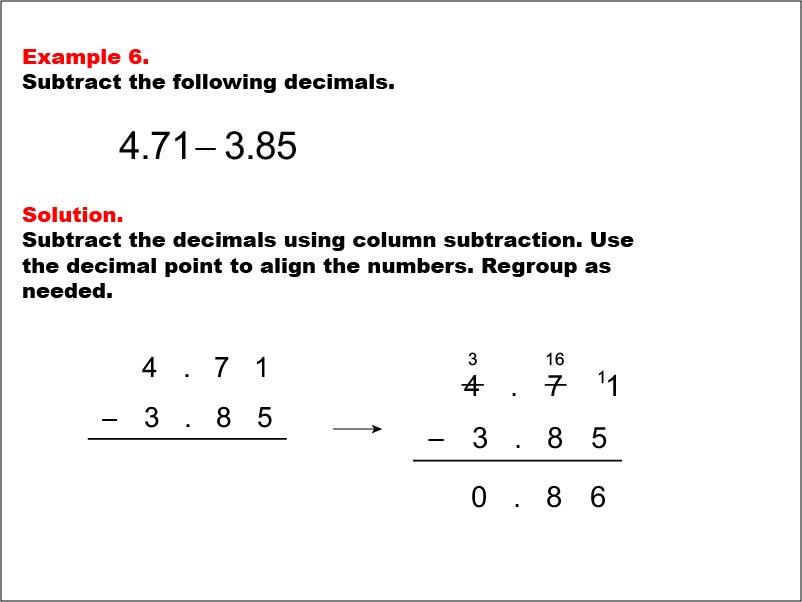
Display Title
Math Example--Decimal Concepts--Subtracting Decimals: Example 6
Display Title
Math Example--Decimal Concepts--Subtracting Decimals: Example 6

Topic
Decimals
Description
This example illustrates the process of subtracting decimals with regrouping in multiple place values. The problem presented is 4.71 - 3.85. The solution demonstrates how to align the decimal points and perform column subtraction, with regrouping (borrowing) in both the tenths and hundredths places. By following this method, students can solve the problem step-by-step and arrive at the correct answer of 0.86.
Subtracting decimals is a fundamental skill in mathematics that builds upon students' understanding of place value, basic arithmetic operations, and the concept of regrouping. This collection of examples helps teach the topic by providing clear, visual representations of the subtraction process, including cases where regrouping is necessary across multiple place values. Students can observe how to align decimal points, perform the subtraction column by column, and handle complex scenarios involving multiple regrouping steps.
Offering multiple worked-out examples is crucial for students to fully grasp the concept of decimal subtraction, especially when regrouping is involved in multiple place values. Each example in this collection showcases different scenarios, from simple subtractions to more complex ones requiring multiple regrouping steps. By exposing students to various problem types, they can develop a comprehensive understanding of the process and gain confidence in their ability to subtract decimals accurately, even in more challenging situations.
Teacher's Script: Let's examine our sixth example of subtracting decimals, which involves regrouping across multiple place values. We have 4.71 minus 3.85. Remember to line up the decimal points. Starting from the right, we can't subtract 5 hundredths from 1 hundredth, so we need to regroup. We borrow 1 tenth from the 7 tenths, making it 6 tenths, and add 10 hundredths to the 1 hundredth, making it 11 hundredths. Now we can subtract: 11 hundredths minus 5 hundredths equals 6 hundredths. Moving to the tenths column, we now have 6 tenths minus 8 tenths, which we can't do. So, we borrow 1 from the 4 in the ones place, making it 3, and add 10 tenths to the 6 tenths, making it 16 tenths. 16 tenths minus 8 tenths equals 8 tenths. Finally, in the ones column, 3 minus 3 equals 0. So, our final answer is 0.86. Remember, when regrouping with decimals, we're still following the same principles as with whole numbers, but we need to be extra careful with our decimal point!
For a complete collection of math examples related to Subtract Decimals click on this link: Math Examples: Subtracting Decimals Collection.
| Common Core Standards | CCSS.MATH.CONTENT.5.NBT.B.7, CCSS.MATH.CONTENT.6.NS.B.3 |
|---|---|
| Grade Range | 4 - 6 |
| Curriculum Nodes |
Arithmetic • Decimals • Add and Subtract Decimals |
| Copyright Year | 2013 |
| Keywords | tutorials, subtracting decimals, tenths, hundredths |